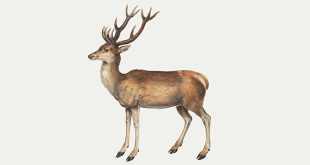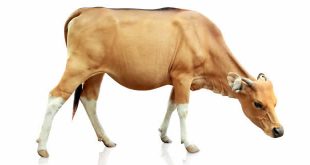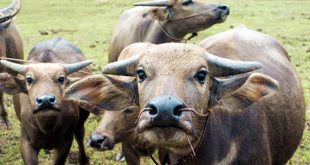 Hippopotamus — The hippopotamus (Hippopotamus amphibius), (hippopotamos, hippos meaning “horse” and potamos meaning “river”), often shortened to “hippo”, is a large, mostly plant-eating African mammal, one of only two extant species in the family Hippopotamidae (the other being the Pygmy Hippopotamus).
Hippopotamus — The hippopotamus (Hippopotamus amphibius), (hippopotamos, hippos meaning “horse” and potamos meaning “river”), often shortened to “hippo”, is a large, mostly plant-eating African mammal, one of only two extant species in the family Hippopotamidae (the other being the Pygmy Hippopotamus).
The hippopotamus is semi-aquatic, inhabiting rivers and lakes in sub-Saharan Africa in large groups of up to 40 hippos. During the day they remain cool by staying in the water or mud; reproduction and childbirth both occur in water, where territorial bulls preside over a stretch of river. They emerge at dusk to graze on grass. While hippos rest near each other in territories in the water, grazing is a solitary activity and hippos are not territorial on land.
Despite their physical resemblance to pigs and other terrestrial even-toed ungulates, their closest living relatives are cetaceans—whales, porpoises and the like. The common ancestor of whales and hippos split from other even-toed ungulates around 60 million years ago. The earliest known hippopotamus fossils, belonging to the genus Kenyapotamus in Africa, date to around 16 million years ago.
The hippopotamus is recognizable for its barrel-shaped torso, enormous mouth and teeth, hairless body, stubby legs and tremendous size. It is similar in size to the White Rhinoceros; only elephants are consistently larger. Despite its stocky shape and short legs, it can easily outrun a human. Hippos have been clocked at 30 mph while running short distances, faster than an olympic sprinter. Despite its popularity in zoos and lazy portrayal in fiction, the hippopotamus is among the most dangerous and aggressive of all animals. There are an estimated 125,000 to 150,000 hippos remaining throughout Sub-Saharan Africa, of which Zambia (40,000) and Tanzania (20,000-30,000) have the largest populations. They are still threatened by poaching for their meat and ivory canine teeth, and by habitat loss.
Hippopotamuses are one of the largest extant mammals in the world. Hippos are considered megafauna, but unlike all other African megafauna, hippos have adapted for a semi-aquatic life in freshwater lakes and rivers.
Because of their enormous size, hippopotamuses are difficult to weigh in the wild. Most estimates of the weight come from culling operations that were carried out in the 1960s. The average weights for adult males ranged between 1500–1800 kg (3,300–4,000 lbs). Females are smaller than their male counterparts, with average weights measuring between 1300–1,500 kg (2,900–3,300 lbs). Older males can get much larger, reaching at least 3,200 kg (7,100 lbs) and occasionally weighing 3636 kg (8000 lbs). Male hippos appear to continue growing throughout their lives; females reach a maximum weight at around age 25.
Hippopotamus amphibius was widespread in North Africa and Europe before the last glaciation event, and it can live in colder climates provided the water does not freeze during winter. The species was common in Egypt’s Nile region until historic times but has since been extirpated. Pliny the Elder writes that, in his time, the best location in Egypt for capturing this animal was in the Saite nome; the animal could still be found along the Damietta branch after the Arab Conquest in 639. Hippos are still found in the rivers and lakes of Uganda, Sudan, Somalia, Kenya, northern Democratic Republic of the Congo and Ethiopia, west through Ghana to Gambia, and also in Southern Africa (Botswana, Republic of South Africa, Zimbabwe, Zambia). A separate population exists in Tanzania and Mozambique.
 Kids Portal For Parents India Kids Network
Kids Portal For Parents India Kids Network






